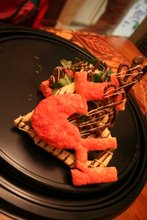Aphrodisiac Foods Recipe Links
Some Interesting History
Source: Cambridge World History of Food
Aphrodisiacs were first sought out as a remedy for various sexual anxieties including fears of inadequate performance as well as a need to increase fertility. Procreation was an important moral and religious issue and aphrodisiacs were sought to insure both male and female potency. Why Certain Foods?In ancient times a distinction was made between a substance that increased fertility versus one that simply increased sex drive. One of the key issues in early times was nutrition. Food was not so readily available as it is today. Undernourishment creates a loss of libido as well as reduces fertility rates. Substances that "by nature" represent "seed or semen" such as bulbs, eggs, snails" were considered inherently to have sexual powers. Other types of foods were considered stimulating by their "physical resemblance to genitalia" It's important to realize these food substances were identified (documented) by the likes of Pliny and Dioscordes (ancient Greeks) first century AD and later by Paul of Aegina from the seventh century. Later more credence was given to foods that "satisfied dietary gratification". Other foods deemed to have these aphrodisiac qualities were derived from mythology. Aphrodite, the love goddess was said to consider "sparrows" sacred because of their "amorous nature" and for that reason were included in various aphrodisiac brews.
There was not always agreement upon what foods were actually aphrodisiacs or "anaphrodisiacs" (decrease potency). But the ancient list included Anise, basil, carrot, salvia, gladiolus root, orchid bulbs, pistachio nuts, rocket (arugula), sage, sea fennel, turnips, skink flesh (a type of lizard) and river snails.The ancients suggested you steer clear of dill, lentil, lettuce, watercress, rue, and water lily.
Saturday, November 24, 2007
Subscribe to:
Post Comments (Atom)


No comments:
Post a Comment